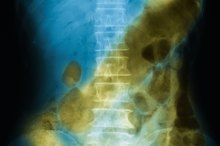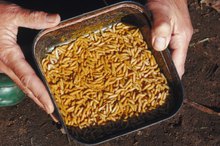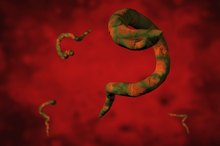Risks of Eating Maggots
Maggots are fly larva. Their small, white, articulated, worm-like bodies usually are found on or near their food source. Maggots eat fecal matter, decaying food and flesh to name a few. They play an important role in the food chain by decomposing rotting biomaterial and recycling usable nutrients back into the earth. Flies lay up to 250 eggs on a food source. Then, the larvae hatch within 20 hours and proceed to feed. Though maggots sometimes are used in medicine to debride and heal wounds, there are risks associated with human and animal ingestion of maggots. Myiasis refers to an infection of any animal by maggots or fly larvae. This is usually seen in livestock such as sheep and cattle.
If you are experiencing serious medical symptoms, seek emergency treatment immediately.
Intestinal Myiasis
Human or animal ingestion of food-harboring fly eggs can cause intestinal myiasis. Once this food is ingested, the eggs can survive the animal’s stomach acid on their way to the intestine, where they will hatch. From there, the larvae can penetrate and implant themselves into the host’s organs, causing internal damage such as:
- bacterial infections
- sepsis and
- if untreated
- death
Though the larvae are likely to fall out of the body because they commonly pupate in dry places, anyone experiencing intestinal myiasis should consult a doctor immediately. Intestinal myiasis usually is treated with purgatives or albendazole, a drug used to in the treatment of various worm infestations.
- Human or animal ingestion of food-harboring fly eggs can cause intestinal myiasis.
- From there, the larvae can penetrate and implant themselves into the host’s organs, causing internal damage such as: * bacterial infections
* sepsis and
* if untreated
* death Though the larvae are likely to fall out of the body because they commonly pupate in dry places, anyone experiencing intestinal myiasis should consult a doctor immediately.
External Myiasis
Parasitic Nematodes in Humans
Learn More
External myiasis occurs when larvae enter the body through any orifice or when flies lay their eggs in open wounds, where the larvae will feed on decaying tissue. Some fly species, such as the screwworm fly, also known as the “flesh eater,” burrow into the skin to feed on live tissue. An individual or doctor can manually extract maggots in a wound. This is a delicate procedure, as the larval body could break during extraction and release skin-irritating fluids into the host. Another method to rid a human or animal wound of maggots is to cut off the maggot’s access to oxygen, using petroleum jelly. This causes the maggot to ascend from deeper layers of skin to be more easily removed. Always seek the advice of your doctor, as an infestation of maggots can lead to skin lesions, sepsis, anemia and even death.
- External myiasis occurs when larvae enter the body through any orifice or when flies lay their eggs in open wounds, where the larvae will feed on decaying tissue.
- Another method to rid a human or animal wound of maggots is to cut off the maggot’s access to oxygen, using petroleum jelly.
Food Poisoning
Maggots are not known to cause food poisoning, per say. In fact, in some circles, crispy fried maggots are considered the height of avant-garde gourmet. So, unless you are relishing a sanitary maggot on toast point, eating maggots is a risky undertaking, because where there are maggots, there is rotting food 5. If you do find yourself eating rotting food infested with maggots, you are likely to vomit, maggots and all 5. This probably is due to food poisoning rather the presence of maggots. When treating food poisoning, keep hydrated and rested. Over-the-counter medications are rarely required but can be used if diarrhea or vomiting persists.
- Maggots are not known to cause food poisoning, per say.
- So, unless you are relishing a sanitary maggot on toast point, eating maggots is a risky undertaking, because where there are maggots, there is rotting food 5.
Related Articles
References
Writer Bio
Based in Los Angeles, Monica Ford has written how-to articles, business marketing and food preparation curricula since 2008. She has consulted with catering outfits from New York to Los Angeles and teaches private traditional food preparation classes in Los Angeles. Ford's writing has appeared on eHow. She holds a Bachelor of Arts in psychology from the University of Texas at Austin.









